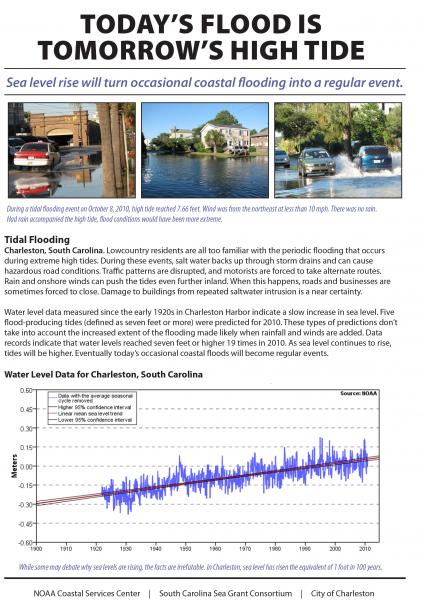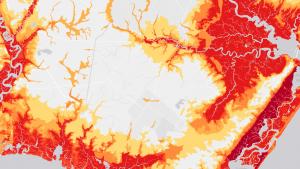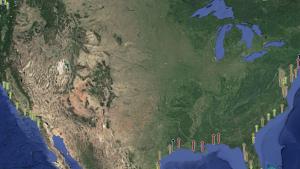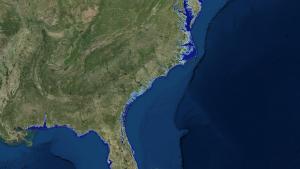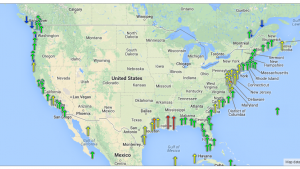Stressors and impacts
Periodic high-tide flooding in Charleston, South Carolina, is a nuisance to residents and visitors. A few times per year, several inches of ocean water inundate portions of the town, causing driving hazards and forcing temporary business closures. And after the waters subside, the salty residue can cause corrosion and decay roads, buildings, and infrastructure. As sea levels rise, the frequency of these floods is increasing, and residents affected by the flooding are anxious to have the problem addressed.
Documenting the city's vulnerability
To characterize the extent of the current and future problem, staff members from NOAA's Office for Coastal Management (OCM) used high-resolution elevation data to generate maps showing areas that are vulnerable to inundation. Based on previous flooding events, they identified 7-foot tides as the threshold above which flooding would occur. To account for rising seas, they generated another category showing the potential extent of flooding when those tides occurred on top of an additional 1.6 feet of water. Consulting predictions for future tides with heights above these thresholds, OCM staff calculated the potential extent of flooding and the number of times it is expected to occur in the future.
A focus group used the map to examine current and future flooding, and to initiate a conversation about the impacts of sea level rise. Participants validated the map results by comparing them with their on-the-ground knowledge of areas that were already experiencing tidal flooding. Participants also discussed the type of information and graphics they believed would be effective in educating local officials about the potential impacts of sea level rise.
Communicating issues and facilitating conversations
Incorporating input from the focus group, partners from the NOAA Office for Coastal Management, the South Carolina Sea Grant Consortium, and the City of Charleston designed and produced a simple handout to use as a communication tool that puts future sea level rise in the context of existing tidal flooding problems. Having a clear, science-supported description of the issue available as a reference helps interested citizen initiate conversations and communicate more effectively with local officials. Producing, distributing, and referring to the handout in various situations is one of the initial steps in a long-term process to increase awareness and better prepare the city for impacts from more frequent tidal flooding as a result of sea level rise.
2025 Update
Charleston's efforts to keep residents and visitors informed about sea level rise and its impacts continue to evolve. Today, the city hosts a Flooding & Sea Level Rise Strategy webpage. Users can find printable documents and interactive StoryMaps describing the City's strategy for adapting to rising sea level.
For more information about how Charleston is building resilience to coastal flooding, read the case study Minimizing the Impacts of Coastal Flooding Helps City Prepare for Sea Level Rise.

